Unit6 Travel 第2课时 语法知识及拓展 课件(共36张PPT)
文档属性
| 名称 | Unit6 Travel 第2课时 语法知识及拓展 课件(共36张PPT) |
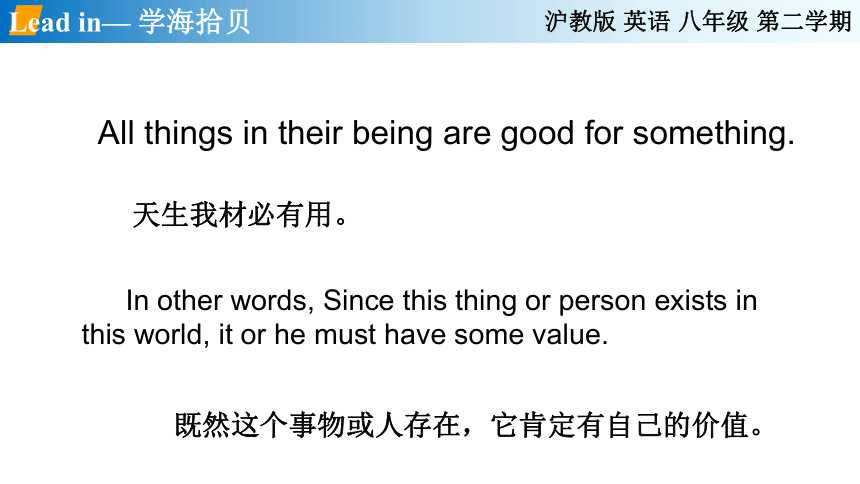
|
|
| 格式 | pptx | ||
| 文件大小 | 458.2KB | ||
| 资源类型 | 试卷 | ||
| 版本资源 | 牛津上海版(试用本) | ||
| 科目 | 英语 | ||
| 更新时间 | 2022-03-09 22:38:01 | ||
图片预览



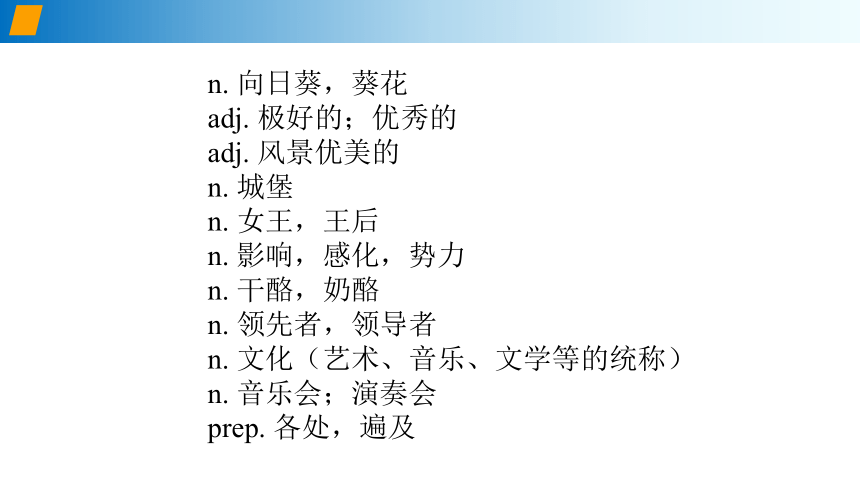
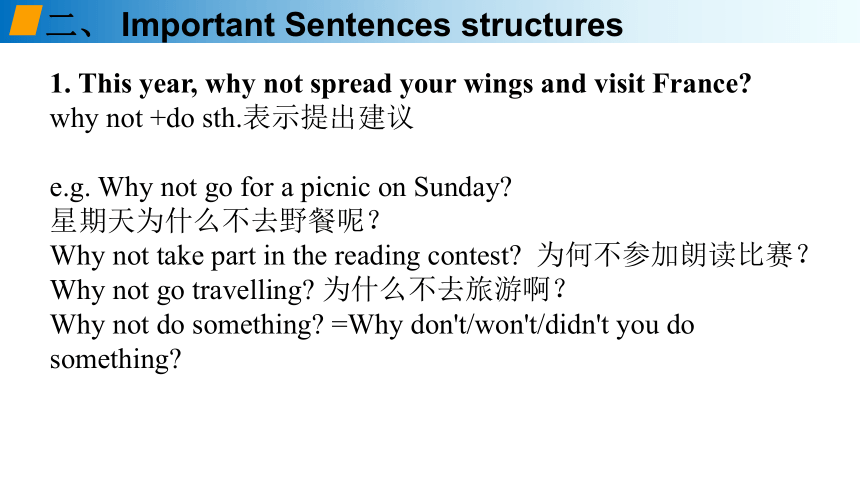
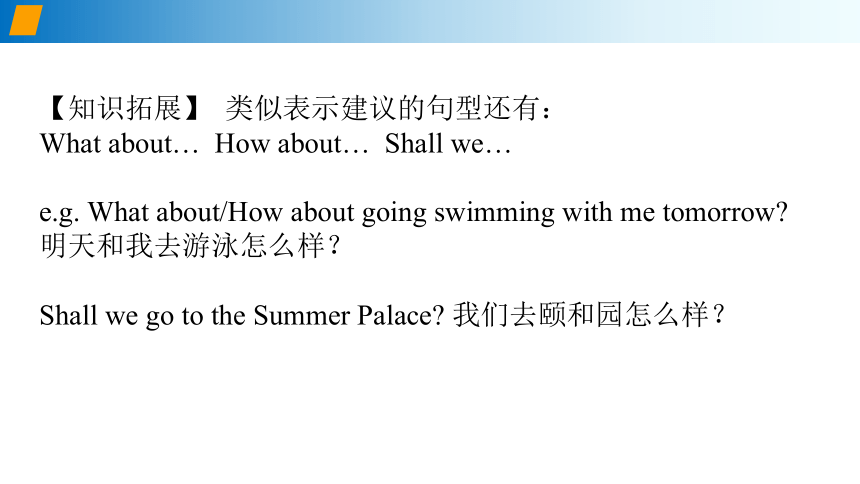
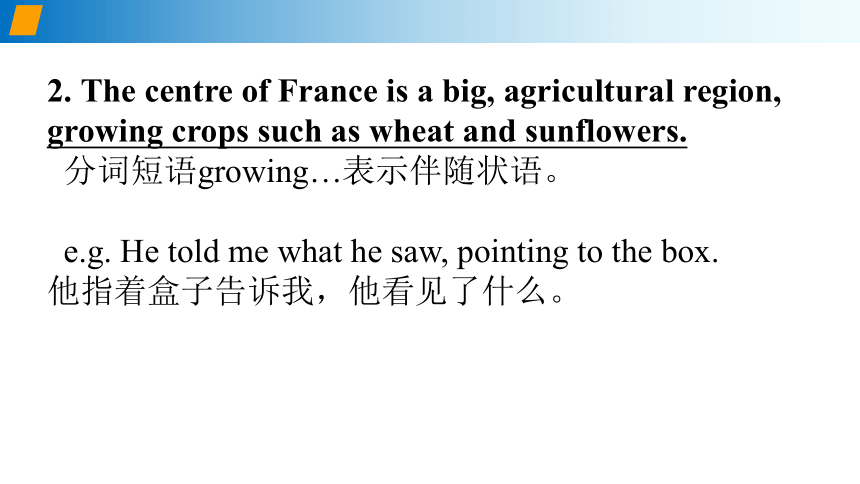
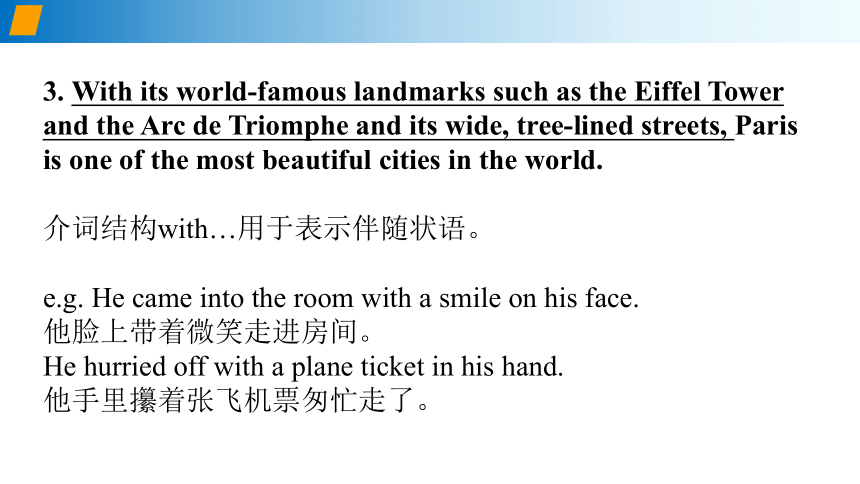
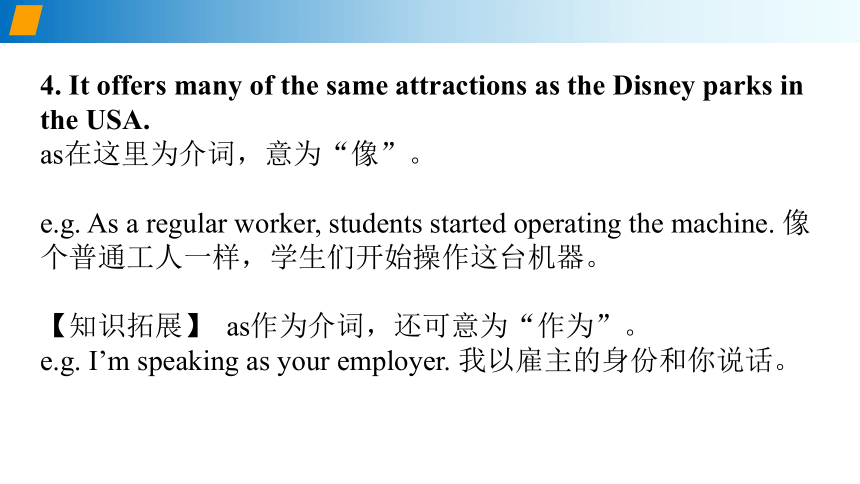
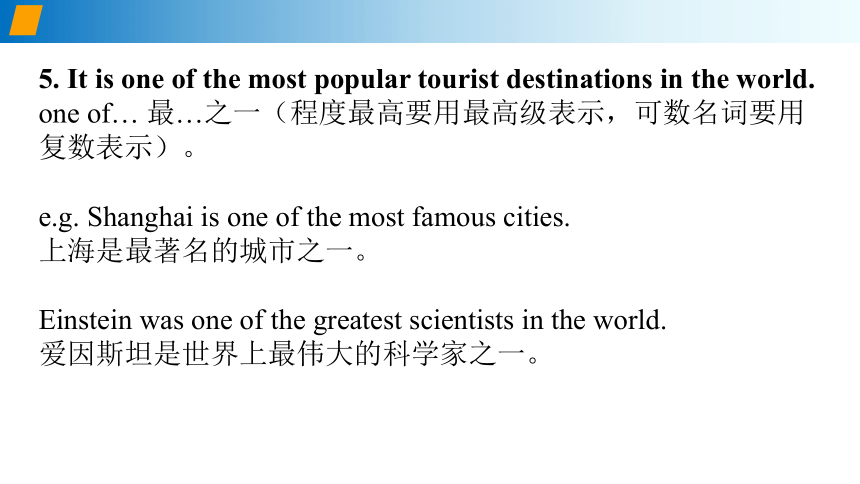
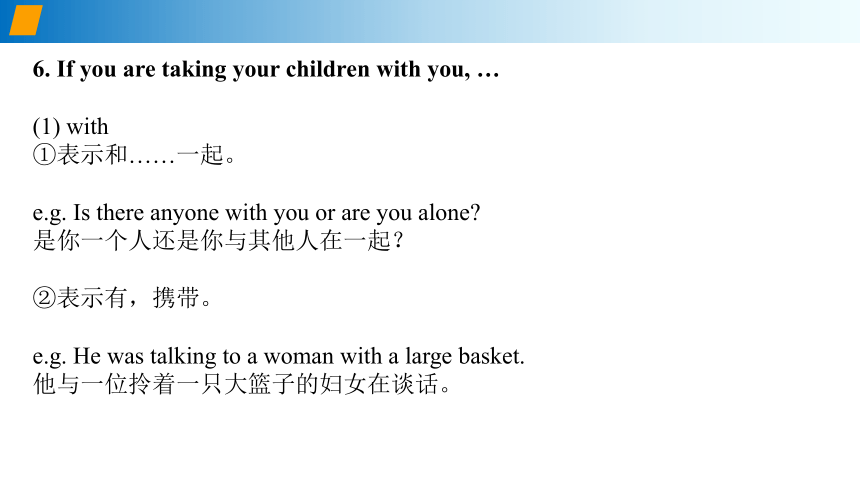
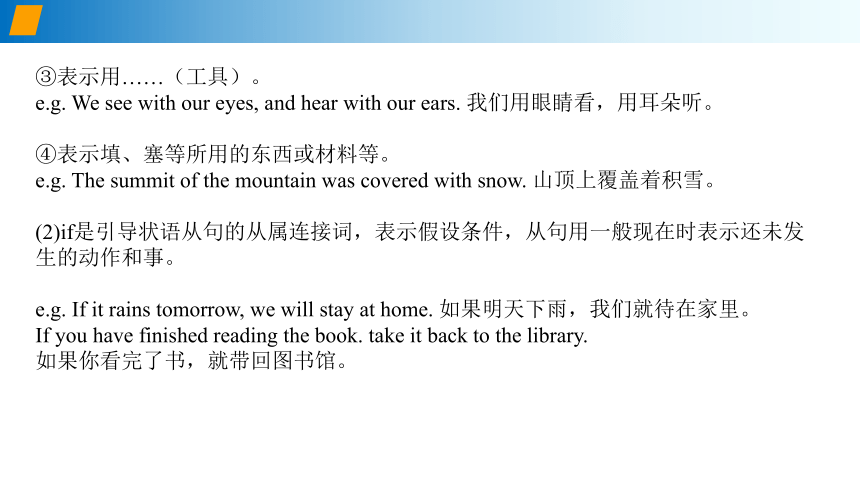
文档简介
(共36张PPT)
All things in their being are good for something.
天生我材必有用。
沪教版 英语 八年级 第二学期
Lead in— 学海拾贝
既然这个事物或人存在,它肯定有自己的价值。
In other words, Since this thing or person exists in this world, it or he must have some value.
Snow and Ice Knowledge 冰雪知识
Curling
沪教版 英语 八年级 第二学期
一、知识回顾
1. 单词默写。
v. 击败;战胜
n. 葡萄酒
n. 成年人
adv. 往国外;海外
adj. 举世闻名的
n. 地标
adj. 绿树成行的;绿树成荫的
n. 名胜,吸引人的事物
v. 使能够,授予权力或方法
adj. 农业的,农艺的
n. 区域;地方
n. 向日葵,葵花
adj. 极好的;优秀的
adj. 风景优美的
n. 城堡
n. 女王,王后
n. 影响,感化,势力
n. 干酪,奶酪
n. 领先者,领导者
n. 文化(艺术、音乐、文学等的统称)
n. 音乐会;演奏会
prep. 各处,遍及
二、 Important Sentences structures
1. This year, why not spread your wings and visit France
why not +do sth.表示提出建议
e.g. Why not go for a picnic on Sunday
星期天为什么不去野餐呢?
Why not take part in the reading contest 为何不参加朗读比赛?
Why not go travelling 为什么不去旅游啊?
Why not do something =Why don't/won't/didn't you do something
【知识拓展】 类似表示建议的句型还有:
What about… How about… Shall we…
e.g. What about/How about going swimming with me tomorrow 明天和我去游泳怎么样?
Shall we go to the Summer Palace 我们去颐和园怎么样?
2. The centre of France is a big, agricultural region, growing crops such as wheat and sunflowers.
分词短语growing…表示伴随状语。
e.g. He told me what he saw, pointing to the box.
他指着盒子告诉我,他看见了什么。
3. With its world-famous landmarks such as the Eiffel Tower and the Arc de Triomphe and its wide, tree-lined streets, Paris is one of the most beautiful cities in the world.
介词结构with…用于表示伴随状语。
e.g. He came into the room with a smile on his face.
他脸上带着微笑走进房间。
He hurried off with a plane ticket in his hand.
他手里攥着张飞机票匆忙走了。
4. It offers many of the same attractions as the Disney parks in the USA.
as在这里为介词,意为“像”。
e.g. As a regular worker, students started operating the machine. 像个普通工人一样,学生们开始操作这台机器。
【知识拓展】 as作为介词,还可意为“作为”。
e.g. I’m speaking as your employer. 我以雇主的身份和你说话。
5. It is one of the most popular tourist destinations in the world.
one of… 最…之一(程度最高要用最高级表示,可数名词要用复数表示)。
e.g. Shanghai is one of the most famous cities.
上海是最著名的城市之一。
Einstein was one of the greatest scientists in the world.
爱因斯坦是世界上最伟大的科学家之一。
6. If you are taking your children with you, …
(1) with
①表示和……一起。
e.g. Is there anyone with you or are you alone
是你一个人还是你与其他人在一起?
②表示有,携带。
e.g. He was talking to a woman with a large basket.
他与一位拎着一只大篮子的妇女在谈话。
③表示用……(工具)。
e.g. We see with our eyes, and hear with our ears. 我们用眼睛看,用耳朵听。
④表示填、塞等所用的东西或材料等。
e.g. The summit of the mountain was covered with snow. 山顶上覆盖着积雪。
(2)if是引导状语从句的从属连接词,表示假设条件,从句用一般现在时表示还未发生的动作和事。
e.g. If it rains tomorrow, we will stay at home. 如果明天下雨,我们就待在家里。
If you have finished reading the book. take it back to the library.
如果你看完了书,就带回图书馆。
Ⅰ. Read and choose the best answer.
( )1. After he traveled New Zealand, he went on Australia.
A. to visit B. visiting C. visited D. visit
( )2. Shanghai used to be a small village,
A. doesn't it B. didn't it C. did it D. didn't they
( )3. Now, many women really like brands LV, Coach and so on.
A. such as B. for example C. is like D. the same as
( )4. everyone's here, let's begin our discussion.
A. Though B. After C. Before D. Now that
【keys】
Ⅰ.1.A 2.B 3.A 4.D
【随堂小练】
Ⅱ. Rewrite the sentences as required.
1. He spreads his wings and visits Japan. (改为一般疑问句)
he his wings and visit Japan
2. Euro Disney is an hour away from the centre of Paris. (就划线部分提问)
___________ ___________ is Euro Disney from the centre of Paris
3. Shall we go to visit the Expo this weekend (保持原句意思)
___________ ___________ going to visit the Expo this weekend
Ⅱ. 1. Does; spread 2. How far 3. What about / How about
冠词
一、不定冠词
冠词是一种虚词,用在名词或名词词组的前面,表示名词是特指还是泛指。冠词可分为不定冠词和定冠词两种形式。不定冠词有a, an;定冠词有the。其中,a用在发音以辅音开头的名词之前,而an则用在发音以元音开头的名词之前。
三、语法讲解
(A)不定冠词的用法:
1. 表示某一类人或某事物中的任何一个,经常用在第一次提到某人或某物时,用不定冠词起介绍作用,表示一个。
e.g. I gave him a book yesterday. 我昨天给了他一本书。
I am reading an interesting story. 我在读一则有趣的故事。
I have got a ticket. 我有一张票。
There is a tree in front of my house. 我的屋前有一棵树。
2. 表示人或事物的某一种类,强调整体,即以其中的一个代表一类。
e.g. A horse is useful to mankind. 马对人类有用。
A bird can fly. 鸟会飞。
A steel worker makes steel. 炼钢工人炼钢。
3. 不定冠词用在事物的“单位”前,如时间、速度、价格等意义的名词之前,表示“每一”。
e.g. We often go to school two times a day. 我们经常每天去学校两次。
I went to the library once a week at least. 我一星期至少去一次图书馆。
The potato is sold at about 30 fen a jin. 土豆卖三毛钱一斤。
4. 不定冠词用来指某人某物,但不具体说明任何人或任何物。
e.g. A boy came to see you a moment ago. 刚才有一个男孩来找你。
I got this tool in a shop. 我在商店买的这件工具。
We need a car now. 我们现在需要一辆车。
She is ill, she has to see a doctor. 她病了,她得去看医生。
5. 不定冠词用于某些词组。
e.g. a few几个(后接可数名词复数)
a little有点(后接不可数名词)
She has a few friends in this city.
她在这个城市中有几个朋友。
There is a little milk in the bottle. 瓶子里有点牛奶。
Only a few students are in the classroom. 只有几个学生在教室里。
(B)不定冠词的位置:
不定冠词常位于名词或名词修饰语前。注意:
1. 位于下列形容词之后:such, what, many, half等。
e.g. I have never seen such an animal. 我从没见过这种动物。
Many a man is fit for the job. 很多人适合这份工作。
2. 当名词前的形容词被副词as, so, too, how, however, enough修饰时,不定冠词应放在形容词之后。
e.g. It is as pleasant a day as I have ever spent. 这是我人生中最愉快的一天。
So short a time. 如此短的时间。
Too long a distance. 距离太远。
3. quite, rather与单数名词连用,冠词放在其后。但当rather, quite前仍有形容词时,不定冠词放其前后均可。如:quite a lot。
4. 在as, though引导的让步状语从句中,当主语为形容词修饰名词时,不定冠词放形容词后。
e.g. Brave a man though he is, he trembles at the sight of snakes. 他尽管勇敢,可见到蛇还是发抖。
(当名词被比较级形容词修饰时,不定冠词通常置于比较级形容词之后。)
二、定冠词
(A)定冠词的用法:
1. 定冠词特指某(些)人或某(些)事物,以区别于同类中其他的人或事物。
e.g. The bag in the desk is mine. 桌子里的书包是我的。
Is this the book you are looking for 这是你要找的书吗?
Do you know the man in black 你知道穿黑色衣服的人是谁吗?
It is not the car we are looking for. 这不是我们要找的车。
The man has found his child. 那个人找到了他的孩子。
2. 定冠词用来指上文中已提到过的人或事物。
e.g. I bought a book from Xinhua Bookshop. The book costs 15 yuan.
我从新华书店买了一本书。这本书值十五元。
I saw a film yesterday. The film was ended at eight o’clock.
我昨天看了一场电影。那场电影八点钟结束。
Lucy bought a radio yesterday, but she found something was wrong with the radio.
露西昨天买了一台收音机,但是她发现收音机有问题。
3. 定冠词用于表示世界上独一无二的事物或用于自然现象或方位名词之前。
the sun the moon the earth the sky the world the winter night
e.g. The sun is bigger than the moon. 太阳比月亮大。
I can see a bird in the sky. 我能看到天空中有一只小鸟。
I like to have a walk with the bright moon light in the evening. 我喜欢晚上在明亮的月光下散步。
4. 定冠词与单数名词连用,表示这一类人或物。
e.g. The cat is an animal.猫是一种动物。
he umbrella in the shop is very cheap in this season. 这个季节商店里的雨伞很便宜。
5. 定冠词与某些形容词连用,使形容词名词化,表示某一类人。
the poor the rich the wounded the sick the deaf
e.g. The wounded were brought to the hospital. 受伤者被送到了医院。
He always helps the poor. 他经常帮助穷人。
The deaf can go to this special school. 耳聋者可以进这所特殊学校上学。
6. 用在序数词、形容词最高级和表示方位的名词前。
e.g. This is the biggest city in China I have ever visited. 这是我在中国参观的最大的城市。
I saw a plane coming from the east. 我看见一架飞机从东方飞来。
He is the last one to help me. 他是最后一个来帮助我的人。
7. 定冠词用在演奏乐器的名称、文艺活动和运动场所的名称前。
e.g. The little girl likes to play the violin. 这个小女孩喜欢拉小提琴。
They are going to the cinema tonight. 他们今晚将去看电影。
The theater was on fire last week. 剧院上周失火了。
8. 定冠词用在报刊、杂志名称的名词之前。
e.g. I am reading the China Daily now. 我正在读中国日报。
Have you got the Evening Paper yet 你拿到晚报了吗?
The Times is a foreign newspaper. 泰晤土报是一家外国报纸。
The Beijing Review is on the desk. 北京周报在桌子上放着。
9. 定冠词用在江河、海洋、山脉、群岛的名称之前。
e.g. We live near the Yellow River. 我们住在黄河边上。
The Changjiang River is the longest river in China.
长江是中国最长的河。
The Himalayas is located in Tibet. 喜马拉雅山位于西藏。
10. 定冠词用在复数姓名之前,表示一家人。
e.g. The Greens are very kind to us. 格林一家人待我们很好。
The Whites like the classic music. 怀特一家喜欢古典音乐。
(B)定冠词的位置:
定冠词通常位于名词或名词修饰语前,但在有all, both, double, half, twice, three times等词修饰名词时,放在这些词之后,名词之前。
e.g. All the students in the class went out. 班里的所有学生都出去了。
【友情提示】冠词与形容词+名词结构:
1. 两个形容词都有冠词,表示两个不同的东西。
e.g. He raises a black and a white cat. 他养了一只黑猫和一只白猫。
The black and the white cats are hers. 这只黑猫和那只白猫都是她的。
2. 如果后面有一个形容词无冠词,则指一物。
e.g. He raises a black and white cat. 他养了一只黑白的花猫。
三、不用冠词的场合:
1. 专有名词、抽象名词和物质名词之前一般不用冠词。
e.g. China is one of the largest countries in the world. 中国是世界上最大的国家之一。
I think water is a kind of food, too.
我认为水也是一种食物。
Cotton feels soft. 棉花摸起来柔软。
2. 表示日常饮食的名词之前不用冠词,但如果指具体的饮食时用定冠词the。
e.g. It's time for breakfast. 该吃早饭了。
What do you have for lunch 你午饭吃什么?
The dinner I had at that restaurant was expensive. 我在那家饭店吃的饭很贵。
3. 在季节、月份、星期、节日、球类运动、棋类游戏的名词之前不用冠词。
e.g. Summer is hot and winter is cold here. 这儿夏天热冬天冷。
New Year's Day is coming. 新年就要到啦。
Today is the first day of May. 今天是五月的第一天。
We are going to play basketball this afternoon. 今天下午我们要去打篮球。
We don't like bridge very much. 我们不太喜欢桥牌。
4. 语言的名称前不用冠词。
e.g. Can you speak English 你会讲英语吗?
It's difficult to learn Chinese well.要学好中文很难。
Tom knows English but he doesn't know French. 汤姆懂英语但不懂法语。
5. 某些固定词组不用冠词。
by air on foot at night after school at home go to class in fact from morning till night
e.g. I'm going to Chicago by air next week. 下周我要乘飞机去芝加哥。
I go to school on foot. 我步行去学校。
In fact, I don't know him at all. 实际上,我根本不认识他。
He is at home today. 他今天在家。
【例l】
After school we usually play___________basketball for half an hour on___________playground.
A. the; the B. 不填;不填 C. 不填,the D. the;不填
【答案】 C
【解析】 此题考查冠词的用法。句意为:放学后我们经常在操场上玩半个小时的篮球。球类运动名词前不用冠词,the表示特指,故选C。
【随堂小练】
【例2】
If you go by train, you can have quite____________comfortable journey, but make sure you take___________fast one.
A. a; a B. the;a C. the; the D. 不填;a
【答案】 A
【解析】 此题考查不定冠词的用法。句意为:如果你乘火车,你能有一个很舒服的旅程,但要确保的是你乘坐快车。根据句意,在这里并不需要定冠词the来特指某一事物,用不定冠词a表示不确定的某个旅程或是乘坐某列火车,故答案为A。
【例3】
We can have___________bluer sky if we create____________ less polluted world.
A. a;a B.a; the, C. the;a D. the; the
【答案】 A
【解析】 此题考查不定冠词的用法。句意为:如果我们创造一个污染少的世界,我们可以有一个更蓝的天空。在这里泛指天空和世界,故答案为A。
【例4】
Beijing is____________capital of China and it is____________city with many places of interest.
A.a;a B.a;the C.the;a D.the; the
【答案】 C
【解析】 本题考查冠词的用法。句意为:北京是中国的首都,它是一座有很多名胜古迹的城市。在这里特指了北京是中国的首都,而北京只是拥有众多名胜的城市中的一座,是泛指,故答案为C。
愿君皆有所获,皆有所得
All things in their being are good for something.
天生我材必有用。
沪教版 英语 八年级 第二学期
Lead in— 学海拾贝
既然这个事物或人存在,它肯定有自己的价值。
In other words, Since this thing or person exists in this world, it or he must have some value.
Snow and Ice Knowledge 冰雪知识
Curling
沪教版 英语 八年级 第二学期
一、知识回顾
1. 单词默写。
v. 击败;战胜
n. 葡萄酒
n. 成年人
adv. 往国外;海外
adj. 举世闻名的
n. 地标
adj. 绿树成行的;绿树成荫的
n. 名胜,吸引人的事物
v. 使能够,授予权力或方法
adj. 农业的,农艺的
n. 区域;地方
n. 向日葵,葵花
adj. 极好的;优秀的
adj. 风景优美的
n. 城堡
n. 女王,王后
n. 影响,感化,势力
n. 干酪,奶酪
n. 领先者,领导者
n. 文化(艺术、音乐、文学等的统称)
n. 音乐会;演奏会
prep. 各处,遍及
二、 Important Sentences structures
1. This year, why not spread your wings and visit France
why not +do sth.表示提出建议
e.g. Why not go for a picnic on Sunday
星期天为什么不去野餐呢?
Why not take part in the reading contest 为何不参加朗读比赛?
Why not go travelling 为什么不去旅游啊?
Why not do something =Why don't/won't/didn't you do something
【知识拓展】 类似表示建议的句型还有:
What about… How about… Shall we…
e.g. What about/How about going swimming with me tomorrow 明天和我去游泳怎么样?
Shall we go to the Summer Palace 我们去颐和园怎么样?
2. The centre of France is a big, agricultural region, growing crops such as wheat and sunflowers.
分词短语growing…表示伴随状语。
e.g. He told me what he saw, pointing to the box.
他指着盒子告诉我,他看见了什么。
3. With its world-famous landmarks such as the Eiffel Tower and the Arc de Triomphe and its wide, tree-lined streets, Paris is one of the most beautiful cities in the world.
介词结构with…用于表示伴随状语。
e.g. He came into the room with a smile on his face.
他脸上带着微笑走进房间。
He hurried off with a plane ticket in his hand.
他手里攥着张飞机票匆忙走了。
4. It offers many of the same attractions as the Disney parks in the USA.
as在这里为介词,意为“像”。
e.g. As a regular worker, students started operating the machine. 像个普通工人一样,学生们开始操作这台机器。
【知识拓展】 as作为介词,还可意为“作为”。
e.g. I’m speaking as your employer. 我以雇主的身份和你说话。
5. It is one of the most popular tourist destinations in the world.
one of… 最…之一(程度最高要用最高级表示,可数名词要用复数表示)。
e.g. Shanghai is one of the most famous cities.
上海是最著名的城市之一。
Einstein was one of the greatest scientists in the world.
爱因斯坦是世界上最伟大的科学家之一。
6. If you are taking your children with you, …
(1) with
①表示和……一起。
e.g. Is there anyone with you or are you alone
是你一个人还是你与其他人在一起?
②表示有,携带。
e.g. He was talking to a woman with a large basket.
他与一位拎着一只大篮子的妇女在谈话。
③表示用……(工具)。
e.g. We see with our eyes, and hear with our ears. 我们用眼睛看,用耳朵听。
④表示填、塞等所用的东西或材料等。
e.g. The summit of the mountain was covered with snow. 山顶上覆盖着积雪。
(2)if是引导状语从句的从属连接词,表示假设条件,从句用一般现在时表示还未发生的动作和事。
e.g. If it rains tomorrow, we will stay at home. 如果明天下雨,我们就待在家里。
If you have finished reading the book. take it back to the library.
如果你看完了书,就带回图书馆。
Ⅰ. Read and choose the best answer.
( )1. After he traveled New Zealand, he went on Australia.
A. to visit B. visiting C. visited D. visit
( )2. Shanghai used to be a small village,
A. doesn't it B. didn't it C. did it D. didn't they
( )3. Now, many women really like brands LV, Coach and so on.
A. such as B. for example C. is like D. the same as
( )4. everyone's here, let's begin our discussion.
A. Though B. After C. Before D. Now that
【keys】
Ⅰ.1.A 2.B 3.A 4.D
【随堂小练】
Ⅱ. Rewrite the sentences as required.
1. He spreads his wings and visits Japan. (改为一般疑问句)
he his wings and visit Japan
2. Euro Disney is an hour away from the centre of Paris. (就划线部分提问)
___________ ___________ is Euro Disney from the centre of Paris
3. Shall we go to visit the Expo this weekend (保持原句意思)
___________ ___________ going to visit the Expo this weekend
Ⅱ. 1. Does; spread 2. How far 3. What about / How about
冠词
一、不定冠词
冠词是一种虚词,用在名词或名词词组的前面,表示名词是特指还是泛指。冠词可分为不定冠词和定冠词两种形式。不定冠词有a, an;定冠词有the。其中,a用在发音以辅音开头的名词之前,而an则用在发音以元音开头的名词之前。
三、语法讲解
(A)不定冠词的用法:
1. 表示某一类人或某事物中的任何一个,经常用在第一次提到某人或某物时,用不定冠词起介绍作用,表示一个。
e.g. I gave him a book yesterday. 我昨天给了他一本书。
I am reading an interesting story. 我在读一则有趣的故事。
I have got a ticket. 我有一张票。
There is a tree in front of my house. 我的屋前有一棵树。
2. 表示人或事物的某一种类,强调整体,即以其中的一个代表一类。
e.g. A horse is useful to mankind. 马对人类有用。
A bird can fly. 鸟会飞。
A steel worker makes steel. 炼钢工人炼钢。
3. 不定冠词用在事物的“单位”前,如时间、速度、价格等意义的名词之前,表示“每一”。
e.g. We often go to school two times a day. 我们经常每天去学校两次。
I went to the library once a week at least. 我一星期至少去一次图书馆。
The potato is sold at about 30 fen a jin. 土豆卖三毛钱一斤。
4. 不定冠词用来指某人某物,但不具体说明任何人或任何物。
e.g. A boy came to see you a moment ago. 刚才有一个男孩来找你。
I got this tool in a shop. 我在商店买的这件工具。
We need a car now. 我们现在需要一辆车。
She is ill, she has to see a doctor. 她病了,她得去看医生。
5. 不定冠词用于某些词组。
e.g. a few几个(后接可数名词复数)
a little有点(后接不可数名词)
She has a few friends in this city.
她在这个城市中有几个朋友。
There is a little milk in the bottle. 瓶子里有点牛奶。
Only a few students are in the classroom. 只有几个学生在教室里。
(B)不定冠词的位置:
不定冠词常位于名词或名词修饰语前。注意:
1. 位于下列形容词之后:such, what, many, half等。
e.g. I have never seen such an animal. 我从没见过这种动物。
Many a man is fit for the job. 很多人适合这份工作。
2. 当名词前的形容词被副词as, so, too, how, however, enough修饰时,不定冠词应放在形容词之后。
e.g. It is as pleasant a day as I have ever spent. 这是我人生中最愉快的一天。
So short a time. 如此短的时间。
Too long a distance. 距离太远。
3. quite, rather与单数名词连用,冠词放在其后。但当rather, quite前仍有形容词时,不定冠词放其前后均可。如:quite a lot。
4. 在as, though引导的让步状语从句中,当主语为形容词修饰名词时,不定冠词放形容词后。
e.g. Brave a man though he is, he trembles at the sight of snakes. 他尽管勇敢,可见到蛇还是发抖。
(当名词被比较级形容词修饰时,不定冠词通常置于比较级形容词之后。)
二、定冠词
(A)定冠词的用法:
1. 定冠词特指某(些)人或某(些)事物,以区别于同类中其他的人或事物。
e.g. The bag in the desk is mine. 桌子里的书包是我的。
Is this the book you are looking for 这是你要找的书吗?
Do you know the man in black 你知道穿黑色衣服的人是谁吗?
It is not the car we are looking for. 这不是我们要找的车。
The man has found his child. 那个人找到了他的孩子。
2. 定冠词用来指上文中已提到过的人或事物。
e.g. I bought a book from Xinhua Bookshop. The book costs 15 yuan.
我从新华书店买了一本书。这本书值十五元。
I saw a film yesterday. The film was ended at eight o’clock.
我昨天看了一场电影。那场电影八点钟结束。
Lucy bought a radio yesterday, but she found something was wrong with the radio.
露西昨天买了一台收音机,但是她发现收音机有问题。
3. 定冠词用于表示世界上独一无二的事物或用于自然现象或方位名词之前。
the sun the moon the earth the sky the world the winter night
e.g. The sun is bigger than the moon. 太阳比月亮大。
I can see a bird in the sky. 我能看到天空中有一只小鸟。
I like to have a walk with the bright moon light in the evening. 我喜欢晚上在明亮的月光下散步。
4. 定冠词与单数名词连用,表示这一类人或物。
e.g. The cat is an animal.猫是一种动物。
he umbrella in the shop is very cheap in this season. 这个季节商店里的雨伞很便宜。
5. 定冠词与某些形容词连用,使形容词名词化,表示某一类人。
the poor the rich the wounded the sick the deaf
e.g. The wounded were brought to the hospital. 受伤者被送到了医院。
He always helps the poor. 他经常帮助穷人。
The deaf can go to this special school. 耳聋者可以进这所特殊学校上学。
6. 用在序数词、形容词最高级和表示方位的名词前。
e.g. This is the biggest city in China I have ever visited. 这是我在中国参观的最大的城市。
I saw a plane coming from the east. 我看见一架飞机从东方飞来。
He is the last one to help me. 他是最后一个来帮助我的人。
7. 定冠词用在演奏乐器的名称、文艺活动和运动场所的名称前。
e.g. The little girl likes to play the violin. 这个小女孩喜欢拉小提琴。
They are going to the cinema tonight. 他们今晚将去看电影。
The theater was on fire last week. 剧院上周失火了。
8. 定冠词用在报刊、杂志名称的名词之前。
e.g. I am reading the China Daily now. 我正在读中国日报。
Have you got the Evening Paper yet 你拿到晚报了吗?
The Times is a foreign newspaper. 泰晤土报是一家外国报纸。
The Beijing Review is on the desk. 北京周报在桌子上放着。
9. 定冠词用在江河、海洋、山脉、群岛的名称之前。
e.g. We live near the Yellow River. 我们住在黄河边上。
The Changjiang River is the longest river in China.
长江是中国最长的河。
The Himalayas is located in Tibet. 喜马拉雅山位于西藏。
10. 定冠词用在复数姓名之前,表示一家人。
e.g. The Greens are very kind to us. 格林一家人待我们很好。
The Whites like the classic music. 怀特一家喜欢古典音乐。
(B)定冠词的位置:
定冠词通常位于名词或名词修饰语前,但在有all, both, double, half, twice, three times等词修饰名词时,放在这些词之后,名词之前。
e.g. All the students in the class went out. 班里的所有学生都出去了。
【友情提示】冠词与形容词+名词结构:
1. 两个形容词都有冠词,表示两个不同的东西。
e.g. He raises a black and a white cat. 他养了一只黑猫和一只白猫。
The black and the white cats are hers. 这只黑猫和那只白猫都是她的。
2. 如果后面有一个形容词无冠词,则指一物。
e.g. He raises a black and white cat. 他养了一只黑白的花猫。
三、不用冠词的场合:
1. 专有名词、抽象名词和物质名词之前一般不用冠词。
e.g. China is one of the largest countries in the world. 中国是世界上最大的国家之一。
I think water is a kind of food, too.
我认为水也是一种食物。
Cotton feels soft. 棉花摸起来柔软。
2. 表示日常饮食的名词之前不用冠词,但如果指具体的饮食时用定冠词the。
e.g. It's time for breakfast. 该吃早饭了。
What do you have for lunch 你午饭吃什么?
The dinner I had at that restaurant was expensive. 我在那家饭店吃的饭很贵。
3. 在季节、月份、星期、节日、球类运动、棋类游戏的名词之前不用冠词。
e.g. Summer is hot and winter is cold here. 这儿夏天热冬天冷。
New Year's Day is coming. 新年就要到啦。
Today is the first day of May. 今天是五月的第一天。
We are going to play basketball this afternoon. 今天下午我们要去打篮球。
We don't like bridge very much. 我们不太喜欢桥牌。
4. 语言的名称前不用冠词。
e.g. Can you speak English 你会讲英语吗?
It's difficult to learn Chinese well.要学好中文很难。
Tom knows English but he doesn't know French. 汤姆懂英语但不懂法语。
5. 某些固定词组不用冠词。
by air on foot at night after school at home go to class in fact from morning till night
e.g. I'm going to Chicago by air next week. 下周我要乘飞机去芝加哥。
I go to school on foot. 我步行去学校。
In fact, I don't know him at all. 实际上,我根本不认识他。
He is at home today. 他今天在家。
【例l】
After school we usually play___________basketball for half an hour on___________playground.
A. the; the B. 不填;不填 C. 不填,the D. the;不填
【答案】 C
【解析】 此题考查冠词的用法。句意为:放学后我们经常在操场上玩半个小时的篮球。球类运动名词前不用冠词,the表示特指,故选C。
【随堂小练】
【例2】
If you go by train, you can have quite____________comfortable journey, but make sure you take___________fast one.
A. a; a B. the;a C. the; the D. 不填;a
【答案】 A
【解析】 此题考查不定冠词的用法。句意为:如果你乘火车,你能有一个很舒服的旅程,但要确保的是你乘坐快车。根据句意,在这里并不需要定冠词the来特指某一事物,用不定冠词a表示不确定的某个旅程或是乘坐某列火车,故答案为A。
【例3】
We can have___________bluer sky if we create____________ less polluted world.
A. a;a B.a; the, C. the;a D. the; the
【答案】 A
【解析】 此题考查不定冠词的用法。句意为:如果我们创造一个污染少的世界,我们可以有一个更蓝的天空。在这里泛指天空和世界,故答案为A。
【例4】
Beijing is____________capital of China and it is____________city with many places of interest.
A.a;a B.a;the C.the;a D.the; the
【答案】 C
【解析】 本题考查冠词的用法。句意为:北京是中国的首都,它是一座有很多名胜古迹的城市。在这里特指了北京是中国的首都,而北京只是拥有众多名胜的城市中的一座,是泛指,故答案为C。
愿君皆有所获,皆有所得
